When the 1000-kilogram bomb exploded outside the Sari Club in Bali on October 12, 2002, no one was prepared. But the least unprepared person, perhaps, was the 44-year-old, 5′1″ female head of the Burns Service of Western Australia. Professor Fiona Wood oversaw the treatment of more people in the aftermath of the Bali bombings than any other person in Australia.
She fought to save people who might otherwise have been given up for dead. Of the 28 people who arrived on the tarmac in Perth she lost only three, whose deaths stay with her. She was a supremely good doctor in the traditional mould: unrelenting in her fight to save lives.
But she was also something more: a scientist who had spent years – mostly at night, while her six children were asleep – working on a new technology to treat burns. After Bali, her revolutionary “spray-on skin” – using a patient’s own skin cells sprayed on to the wound to form a new top layer of skin – came suddenly to public attention, brightening those dark weeks with the gleam of a miracle.
Of course, not everyone believes in miracles. At the time, various Australian burns specialists rejected Wood’s innovation (which she developed with scientist Marie Stoner) and refused to use it. Today, however, it’s been used on some 15,000 patients across more than 30 countries, including the US, where it was FDA-approved in 2018.
In 2005, Wood was named Australian of the Year. She has an Order of Australia; she is a National Living Treasure; she has been voted the “most trusted” person in the country a record six times. This June, she was awarded the Australian Society for Medical Research medal. And yet, she tells me kindly, it’s unlikely she will read this profile. She’s both a confident and a self-deprecating person, and for both reasons, she finds watching or reading about herself “excruciating”.
Which is why, at 64, there’s a glowing biography about her, to be published next week, that she has not read; a new Stan mini-series about the Bali bombings (in which she is played by Rachel Griffiths) that she has not seen; and a multitude of new burns technologies – including intelligent surgical tools, 3-D skin printers and scarless healing cream – that she cannot stop talking about.
The meeting room at the Harry Perkins Institute of Medical Research in Perth is typically corporate: no natural light, functional furniture, neutral colour scheme. But there’s nothing neutral about Professor Fiona Wood. She bustles in, pushing her sunglasses to the back of her head and offloading her enormous handbag. She has a wide, friendly face, with the particularly even tan of English people who’ve avoided the sun damage of Australian childhoods, and she’s dressed in several layers of pale pink and white, a long strand of her trademark pearls around her neck. (If she and fellow Western Australian Julie Bishop went head to head in a pearl-off, it would be a battle to the death: Wood’s friends say the one glaring error in the new mini-series is that “the pearls are just not up to scratch”.) Her small feet are clad in high-top sneakers covered with sparkling gold sequins.
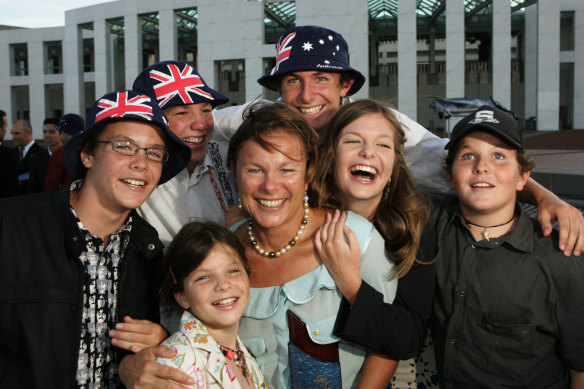
Wood and her six children in 2005, in Canberra for her Australian of the Year award.Credit:Andrew Taylor
She has just returned from a family holiday in Broome with five of her six children (aged from 28 to 36). She has a lovely voice, still burred with her native Yorkshire, and when she gets excited or wants to make a point she occasionally swears under her breath. As always, she seems incredibly busy – she got off the plane last night just in time to give a speech for surgical trainees alongside her older brother David, an orthopaedic surgeon who also lives in Perth.
“He’s the archetypal straight white male, and he had this wonderfully professional PowerPoint talk,” she explains. “And then I just stood up and told stories. I thought he was so much better than me, then I realised, ‘No. He’s a 6′4″, rugby-playing orthopaedic surgeon, whose dominoes have fallen absolutely straight, who has a nurse as a wife who’s looked after him every day of his life. And I’m this midget weirdo who doesn’t fit any mould, whose dominoes have scattered in every direction’ ”
She grins. “So I reconciled myself: his professional PowerPoint was a reflection of him; and my inciting them to riot – to do what they want to do rather than what they’re told to do – was a reflection of me.”
Wood has always done what she wanted to do – which is not to say she’s undisciplined, but that she is undeterred by obstacles. The child of a fifth-generation coal-mining family in Yorkshire, she was teased in primary school because she loved learning until she fought the boys in question – a proper punch-up – and they left her alone.
At medical school in London, she was a small, working-class woman in immaculate clothes in a sea of privileged men, none of whom imagined she would have the presumption to want to be a surgeon. “Part of me liked that,” she admits cheerfully: “‘Oh, you want to tell me I can’t do that, do you?’ ”
“So I’ve got the job? You’re sure? Good. Because I’m pregnant again.”
She made up her own mind during her very first anatomical dissection class. “I still remember what I was wearing,” she says, her voice dropping: “Yellow loon pants and a cream polo-neck. And we were doing a forearm. I remember just thinking, ‘Oh my god, this is amazing.’ The way everything moved inside the arm –so beautiful. And I thought, ‘Yes. I’ll put this back together again.’ And I did.”
In 1987, when she arrived in Perth with her general-surgeon husband Tony Kierath, she was refused a position in plastic surgery because she had two small children. After a year of ferocious success as a general surgeon, in 1989 she became the first female plastic and reconstructive surgery registrar in WA history. “So I’ve got the job?” she recalls asking Royal Perth Hospital. Yes, they told her. “You’re sure?” Yes. “Good. Because I’m pregnant again.”
In 1998, Valerie Sloss suffered burns to 85 per cent of her body after a light-airplane crash, while flying from Perth to a friend’s property on the state’s south coast. No one thought she’d survive. Wood took on her treatment: putting Sloss in a coma for four weeks, operating on her repeatedly, caring for her in hospital for 10 months.
Sloss remembers it as “one long nightmare” with one bright spot: the very short figure who kept appearing at her bedside. “She wasn’t Dr this or Dr that – she just said, ‘I’m Fiona,’ ” recalls Sloss. “You’re so vulnerable, so confused, and there’s this person – so reassuring, so friendly, so competent. She was a complete godsend.”
There’s no doubt Wood is unusually close to her patients. A mad cyclist and swimmer, she would visit them in her bike shorts on days off; she still gets tears in her eyes recalling patients she’s lost, and takes jubilant pleasure in those who recover.
Mark Mulder, who was not expected to live when a jerrycan of petrol ignited in his hands in 1992, still remembers the day he left Royal Perth after almost a year. “Fiona was operating, and somehow she heard the news,” he recalls, grinning. “She came flying through the hospital – I don’t know what she’d done with her patient, but she was shouting, ‘Don’t let him leave until I get there!’ ”
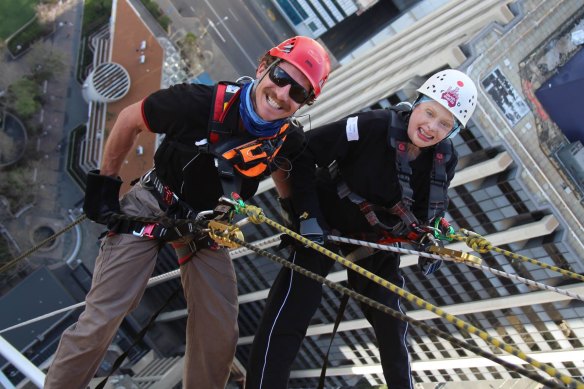
Former patient Valerie Sloss (right) abseiled off the Central Park Building in Perth in 2017 to raise money for the Fiona Wood Foundation. Credit:Zenith Events
She accepted this emotional connection to her patients, she admits, when she entered medicine. But she couldn’t accept their fate. “Initially, it was the physical scarring that drew me,” she says, “because it seemed so terrible. And then the psychological scarring; then later, the physiological scarring – the fact that in some people, burn injury changes their make-up so they have increased risk of other diseases, even premature death. That scarring triangle is what drives our research.” She pauses. “Fundamentally, the research is a coping strategy for me. I see terrible things. And if I didn’t continue to believe that at some point we were going to do better, how would I ever have stayed at the table? That’s what’s driven me all through these decades: we will do better. And I will be responsible for that. I will own it.”
Wood’s spray-on skin technology was her first famous attempt at “doing better”. And today, she’s not only a consultant plastic surgeon at Perth Children’s Hospital and Fiona Stanley Hospital (named after the state’s other famous Fiona) and director of the WA Burns Service (which treats 275 in-patients and 3500 out-patients each year), she’s also director of the University of Western Australia’s Burn Injury Research Unit.
“That’s what’s driven me all through these decades: we will do better. And I will be responsible for that. I will own it.”
Just down the corridor from our meeting room, this unit has several projects underway. Among them is a new surgical tool they call an “iKnife”, in which smoke and aerosol produced by diathermy (a surgical technique using high-frequency electrical current) is analysed to show if a surgeon is cutting through live or dead tissue – one of the most difficult challenges of burn wound surgery.
“We’ve done the lab work on human tissue to show it can instantly distinguish between damaged and healthy tissue in burn skin,” explains associate professor and senior researcher Mark Fear: the next step is for Wood to test the tool (which has been trialled in cancer treatment, but never used clinically) in surgery. “The idea is that Fiona will use it in surgery, on her judgment, and we’ll see what it tells us. At this stage, we wouldn’t be using it to guide the surgery.”
But that’s the ultimate goal: a tool that would allow any surgeon to be as good at distinguishing between healthy and non-viable tissue as, well, Fiona Wood – and help Wood herself, as she would no doubt say, to be even better.
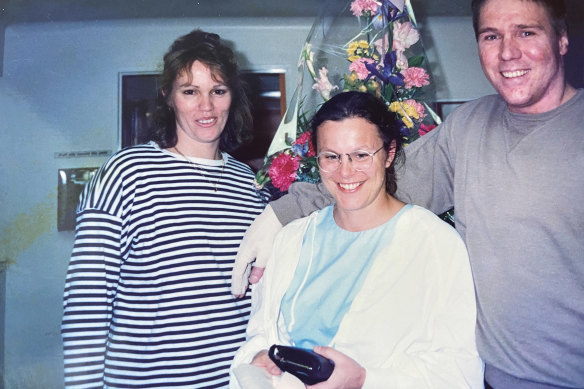
Mark Mulder and his wife, Liz, with Wood (centre) after she helped him survive burns to 92 per cent of his body.Credit:Pictures from Under Her Skin, By Sue Williams (A&U), Courtesy of Fiona Wood
Another project close to Wood’s heart is 3-D bio-printing. The goal here is to allow surgery to literally replace the deeper layers of human skin for the first time. No existing product can do this – even spray-on skin, for example, replaces mostly epidermal cells – “so we need that next step,” says Wood.
The dermis is the complex secondary skin layer containing blood vessels, hair follicles, sweat glands, collagen and nerves; the goal of 3-D bio-printing is to “print” droplets of all these cells directly into wounds. In collaboration with other groups, including a team led by Wollongong University’s Professor Gordon Wallace, Wood and Fear hope to be ready for a pilot study on humans by the end of next year.
Last, but not least, in Wood’s cabinet of miracles is a so-called scarless healing cream. Scars form when collagen – the most abundant naturally occurring protein in the body – changes in response to trauma. “With a burn, collagen production goes into overdrive,” says Wood. “And it gets laid in these very regular bundles, which are tethered tightly together by a particular enzyme.” But if you block this enzyme, the bundles may untether, re-forming into something more like normal skin. Over time, they might change so much that the scar itself fades or disappears.
As we speak, Wood and her team are running a clinical trial in WA on participants with established scars. “I had one guy this morning,” she says excitedly. “And we were sitting there, and he looked at his scar and I looked at his scar. And he said, ‘It’s different, isn’t it?’ And I said, ‘Yeah, it is.’ And he said, ‘Have I got the stuff [the treatment cream as opposed to the placebo]?’ and I said, ‘I don’t know. Maybe you’re massaging it, maybe it’s the planets aligning.’ ” She smiles – the smile of one who has seen the future and found it, maybe, scar-less. “By Christmas, we should know.”
Wood’s childhood was a perfect training ground for a career involving incredibly hard work against incredibly long odds. She grew up in the coal-mining village of South Elmsall in West Yorkshire. Her beloved father went down the pit – the famous Frickley Colliery – at 14, spent 27 years there, and “hated it every single day”. “I remember the feeling that I didn’t fit in,” says Wood. “No one in my family did. We were a very tight unit, and we were different. We were brought up to leave, and we all knew it.”
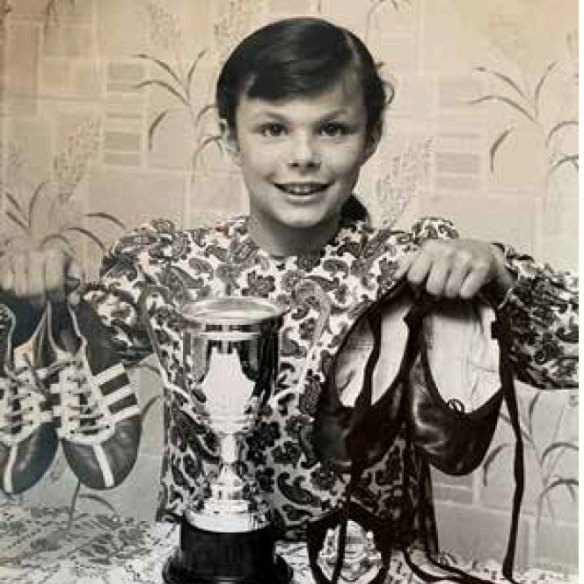
As a child, Wood was a champion sprinter and good ballet dancer.Credit:Pictures from Under Her Skin, By Sue Williams (A&U), Courtesy of Fiona Wood
Nonetheless, her first home left its mark. During the final, terrible coal miners’ strike against Margaret Thatcher’s Conservative government in 1984-85 – widely regarded as the most bitter industrial dispute in British history – the Frickley miners became known by the motto “Second to none” because so few of them crossed the picket line. Wood grew up among people prepared to keep fighting despite overwhelming odds.
As a child, Wood was a champion sprinter, a good ballet dancer and an excellent student. The local comprehensive, however, only went up to year 10, making university entrance impossible. As determined as her daughter, Wood’s mother Elsie applied for a job at Ackworth, an 18th-century, Quaker-founded, elite private school fortuitously close to their village. The job included the chance for Wood and her younger sister Nicola to become pupils at drastically reduced fees – at the time, Ackworth was the eighth most expensive school in England.
And so the heirs to families such as the Barclays, Cadburys and Rowntrees were joined by “the coal miner’s daughters!” laughs Wood. “But it was magical: like being let loose in the lolly shop. I didn’t get beaten up, and I could learn. I had friends …” she pauses. “Was I cool? I don’t think so. I certainly didn’t run with the crowd – didn’t need to.” She smiles. “I always thought the most important thing is not to need to. When you think of how battered and bruised kids are these days by social media, that’s a gift.” In her final year there, she was head girl and dux.
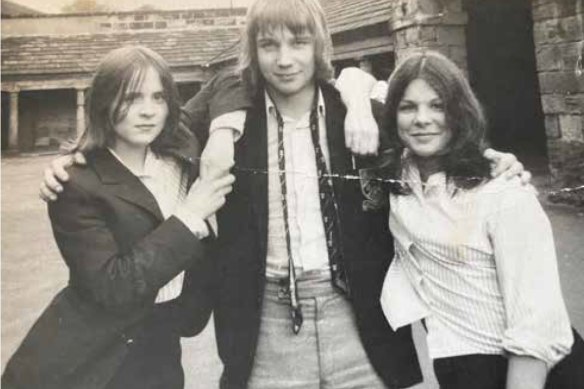
Wood aged 14 (right), with school friends Jane and Chris.Credit:Pictures from Under Her Skin, By Sue Williams (A&U), Courtesy of Fiona Wood
After high school, she followed her older brother David to St Thomas’s Hospital Medical School in London. (Her other brother, Geoff, studied law at Cambridge. He died of an asthma attack at just 33.) She was one of 12 girls among 69 students. “Once again, didn’t fit in, didn’t matter,” she remembers. “Actually, it was liberating – there were no formulas you had to follow.”
In her final year, two dramatic things happened: she met Tony Kierath, a fellow student, from Western Australia. And she failed her final College of Surgery exams. Wood met Kierath in March 1985; he asked her to marry him three weeks later. What was it about him that struck her so powerfully? “He was smart,” says Wood immediately. “Bit exotic. Different. And didn’t care to fit in. All the boys were there in their uniform of sports jackets and old school ties, and he’s in his Dunlop Volleys and a jumper his mum knitted. And I thought, ‘Hmm. Interesting.’ ”
Since their marriage, Kierath has preserved a total media silence, never appearing in any story about Wood, and declining to be interviewed for her biography (Under Her Skin, by journalist Sue Williams). “I think people thought Mum was a single mother for a long time,” eldest daughter Jessica Kierath told Williams. “Dad was like a white ninja, always in the shadows.”
The pair married 12 weeks after meeting, and Wood failed her exam the following month. “I always tell Tony he’s the reason I failed. He was the distraction!” It remains the only evaluation of any kind she’s ever messed up. I can hardly believe it, I say. “It surprised me, too, I can tell you!” says Wood. She retook the exam three months later, and passed. By this time, she was pregnant with her first son, Tom. Jessica followed just over a year later, then four more in quick succession: there are only eight years between the six children.
Wood says that she and Kierath wanted lots of kids “so they could look after each other. And they did!” When I tell this to Jessica Kierath – now 33, a recently qualified plastic surgeon herself – she rolls her eyes. “I know people always presume we were neglected,” she laughs, “or raised by nannies. But we never had a nanny after my younger sister went to pre-primary. Mum and Dad did work a lot. But Mum used to take us to the hospital all the time; and when she was home, she was really there.
“On Saturday mornings, she would write out these maths quizzes, with different questions calibrated to our different ages, and the answers would spell out a code describing where a treat was hidden. And another time she made me a full doll’s house, with all the curtains and the bedspreads hand-sewn, and the little shingles on the roof made from tongue-depressor sticks.”
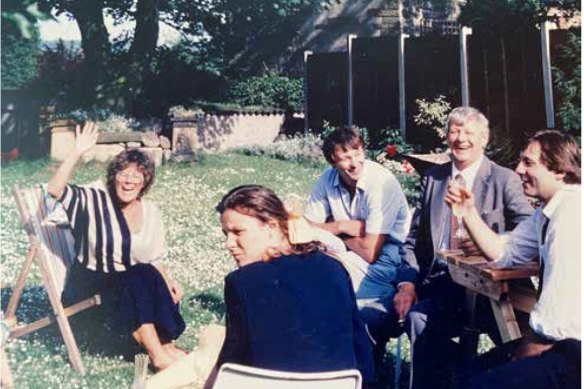
Wood (centre) relaxing at the family home with her mum and dad, Elsie and Geoff, and her brothers David (left) and Geoff (right), in 1985.Credit:Pictures from Under Her Skin, By Sue Williams (A&U), Courtesy of Fiona Wood
In 2002, Wood was part of a taskforce that presented a national disaster response plan to the federal government. The plan was accepted in August 2002, and work had begun for a national mass-casualty simulation exercise. Instead, we got Bali.
David Fyfe was a young soccer player on his end-of-season jaunt in Kuta 20 years ago; today he’s CEO of WA’s largest energy supplier, Synergy. After the bombings, he arrived in Perth unconscious, with burns to more than 50 per cent of his body. Wood operated on him multiple times. She amputated his leg; she used spray-on skin on his arm and hand (where, he shows me, pulling up his business shirt sleeve, he now has virtually no scar). Nine years ago, she persuaded him to join the board of the Fiona Wood Foundation – a charitable organisation for burns research she co-founded in 1999.
“I remember waking up 12 days after Bali, strapped into the crucifix position, no idea what had happened,” Fyfe recalls. “And as soon as she walked into the room, I felt better. She’s an exceptional leader: so calm, so caring, but able to make tough decisions.” She’s also modest. “She has no interest in being famous,” he says. “When she set up the foundation, for instance, she named it after one of her old mentors [Harold McComb]. Then, after Bali, the board realised that her name would really entice people – large corporates, for example, want to be part of it because she carries so much respect and legitimacy.” He laughs. “So she’s accepted [the name change], but she’d rather not have it – not in any way. She’s just driven to make things better for patients.”
“She has no interest in being famous. When she set up the foundation, she named it after one of her old mentors.”
As a recipient of her spray-on skin, Fyfe feels he’s been a personal beneficiary of this drive. Which made it hard for him to watch when Wood was criticised in the aftermath of the Bali bombings. Although Wood and her team had been using the technology for more than a decade, and had published 11 years’ worth of patient case studies, their spray-on skin had not yet been tested in formal clinical trials. “But imagine if she’d waited for those,” says Fyfe. “They took years afterwards! It wouldn’t be on me, it wouldn’t be on anybody from Bali. As a recipient, it’s really frustrating for me that more people haven’t been able to receive it.”
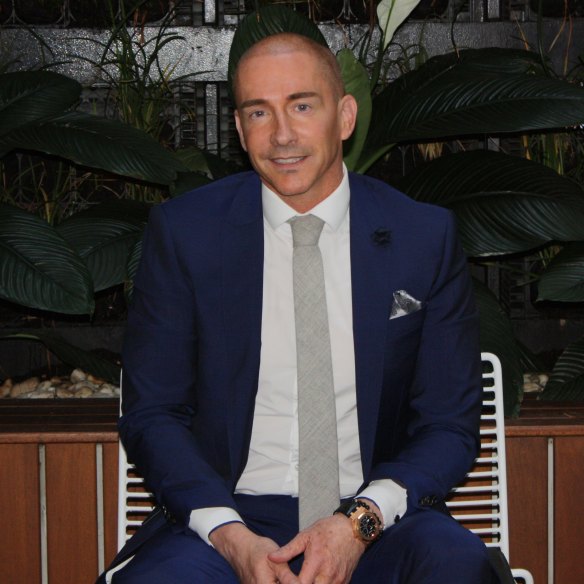
David Fyfe suffered burns to more than 50 per cent of his body and was treated by Wood. “As soon as she walked into the room, I felt better,” he says.
James Hill Holmes IV, director of the burn centre at Wake Forest Baptist Medical in North Carolina, one of America’s major burns hubs, was involved in the US trials for spray-on skin, now called ReCell. He has known and admired Wood since the early 2000s. “Until 2008, I was doing the same burn operations, day in day out, for 30 years,” he says. “Operatively, things had not progressed since I was at high school. And that’s a pretty depressing place to be. And then Fiona’s idea of spray-on skin comes along, and it’s the first new tool for the toolbox in two or three decades.”
“ReCell has been fantastic,” agrees Joseph Molnar, professor of plastic and reconstructive surgery at Wake Forest and an internationally respected burns researcher. “Fiona is an excellent surgeon and an inspiring person. And a great researcher. I can’t wait to get some of this cream she’s been working on.”
And yet, Holmes points out, “It’s been fascinating, and sickening, to see the petty jealousy she’s been subjected to. Outside of WA, the burns world is fairly misogynistic, and a lot of them have been motivated by jealousy.”
Some assume Wood has made a fortune from spray-on skin. “Everyone thinks that every time someone uses it, anywhere in the world, Fiona is making money,” says Holmes. “And that is not the case.” Wood has certainly made something from her invention. But she and Marie Stoner don’t own the company that makes it (AVITA Medical), and they assigned their intellectual property – and thus any royalties they might make – to the foundation some 20 years ago. “Basically, we set it up so that any money would get ploughed back into research,” she says.
Wood does own shares in AVITA, and receives “a stipend” as a scientific and clinical adviser. But while it’s clear that, like most surgeons, she and Kierath are well-off – they have a property in south-west WA, and part-own a house in Japan’s ski fields – she shows no signs of being a pharmaceutical robber baron, nor even of being particularly interested in money. All her proceeds from the biography will go to the foundation, as do donations in lieu of fees for the 50-odd professional speaking engagements she does annually. (Her pearls, incidentally, are bought for her by Kierath, who began the tradition after she put her sapphire engagement ring into her scrubs pocket one day and lost it to the hospital laundry.)
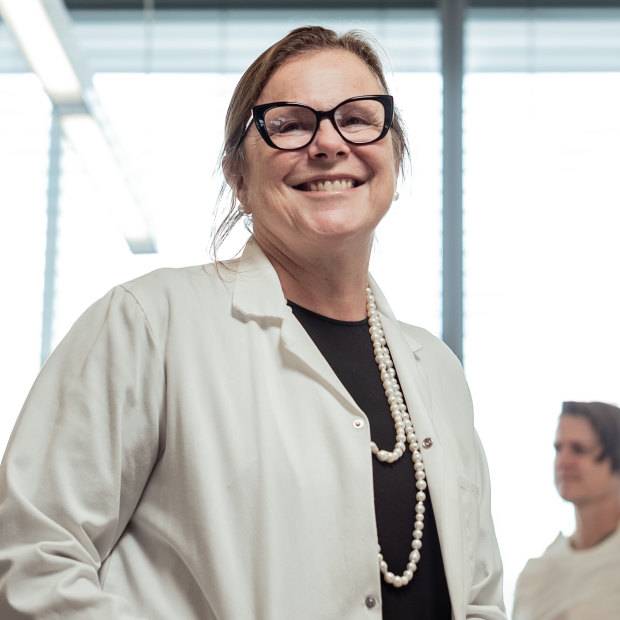
Wood has faced criticism over the years for her spray-on skin. “My energy and my time are my currency. There are people’s minds you will never change, so why bother?” she says in response.Credit:Tony McDonough
As for the criticism over the years, “Sometimes it does get under your ribs,” she says. “But my energy and my time are my currency. There are people’s minds you will never change, so why bother?”
She looks frustrated for a moment, then smiles. “That being said, burns units across the country work much more collaboratively now than they once did. And it’s really great to see everyone come together. We’re part of a [national] project about paediatric dressings at the moment; we’ve got studies on the impact of high-dose vitamin C, low-dose aspirin in the works [with other states]. Can we answer those questions on our own? No – but with everyone, we can really get things done.”
“Fiona is a great doctor,” says Professor Peter Maitz, director of the burn unit at Concord General Hospital in NSW, “and she thinks outside the box. She has encountered a lot of resistance over the years, but she has moved the whole profession forward. And if there is a group of old boys who need that, it is burns specialists!”
This kind of wide-ranging research is beginning to yield extraordinary information about the broader impacts of burn injury. Ongoing research suggests, for instance, that for a significant number of people, burns can literally change the course of their life. Some kids who have suffered burns seem no longer to respond as well to their childhood vaccinations; teens who have been burnt (even as small children) appear more likely to require hospitalisation for mental illness, and stay in hospital for longer, than their contemporaries; and some people of all ages who’ve been burnt – not even a life-threatening burn, just one requiring hospitalisation – appear to be more likely to die early of infections, cancer, trauma and other diseases, than the general population.
“People say, ‘Oh, that’s bad luck.’ Well, if you’re looking down the barrel of that bad luck, you want more than that.”
In some ways, says Wood, this isn’t so surprising. All burns doctors have stories about patients they’ve successfully treated who later died, inexplicably, of other causes. In 2000, Wood saved the life of a seven-year-old boy called Michael. As part of a team of seven plastic surgeons, burns nurses and anaesthetists working on rotation, she operated on him for nine-and-a-half hours, refusing to leave his side during breaks.
When the heating failed (due to heat loss through damaged skin, burns surgery is conducted at a stifling 32 degrees), she covered him in dressings and climbed onto the operating table, cradling him in her arms to keep him warm. He was in hospital for four months, but recovered well. Then, at 11, he was diagnosed with liver cancer. He died the following year, having had no risk factors for the disease. “People say, ‘Oh, that’s bad luck,’ ” says Wood, her eyes very bright. “Well, if you’re looking down the barrel of that bad luck, you want more than that. Could it be the burn? And if so, how? What makes you vulnerable?”
Answering this question, she says, is where the future of burns treatment lies. “If I knew that your burn injury would lead to systemic changes, such that you had an increased risk of cancer or heart disease, and if I could change that – eliminate your risk, restore your life as if you had never been burnt?” She sits back. “That’s gold.”
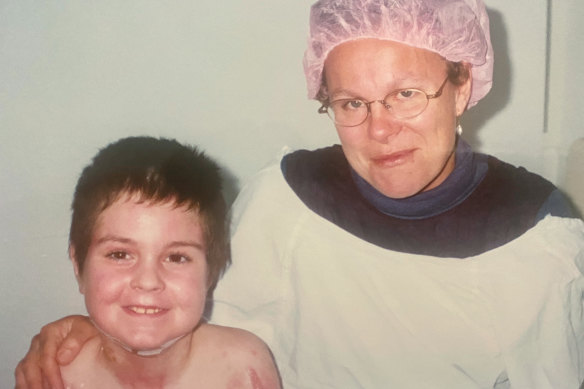
Michael Stubberfield, who survived burns surgery at age seven, then died four years later – Wood wants to know how the events may have been related.Credit:Pictures from Under Her Skin, By Sue Williams (A&U), Courtesy of Fiona Wood
The day after our interview, I meet Wood again, this time late in the afternoon at The University Club of Western Australia, close to the Swan River. She orders chardonnay and hot chips, and we sit in the slanting, golden light while Wood explains her goals for the next few years. She wants to do less clinical work and more research. She hopes to establish an endowed chair in burns trauma research at the University of Western Australia, to “guarantee burns research forever”. And she wants to get a bit further down the path towards the holy grail of scarless healing.
“We know very little about the brain’s response to burn injury,” she says, putting her chardonnay down. “We know that the nerves change afterwards, and we know that a burn is a massive inflammatory event. So if we could control that inflammation, using neural input, in a vulnerable individual, could we actually regenerate?” She laughs, but leans forward. “Could we literally think ourselves whole?”
Wood herself knows how unlikely this kind of seamless healing sounds. “I lie in bed visualising normal knee anatomy,” she confesses (she has had two knee-replacement operations), “and then I think, ‘Back up the truck. I have giant bits of metal in there – no brain exercises are going to help me now!’ But neurology – I’m sure the seat of the answer lies there.”
She leans back, closing her eyes for a moment, soaking in the sun. “We’re gathering the data. But what we want in the future is to treat the patient, not the bell curve.” She opens her eyes. “I’d like to know who is at risk. Who’s at risk of terrible scars? Who’s at risk of a change in their life trajectory: of cardiac disease or cancer? All this takes us out of the realm of surgery and into the realms of health, and wellness, and exercise, and inflammation and diet and microbiome and all these amazingly interesting things.” She picks up her chardonnay. “You’ve got to maintain your curiosity. You’ve got to keep asking the questions.”
To read more from Good Weekend magazine, visit our page at The Sydney Morning Herald, The Age and Brisbane Times.